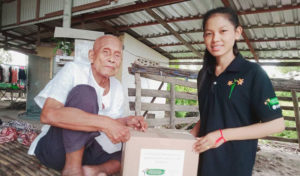Found on the island of Jiigurru, the 82 shards predate the arrival of Europeans by centuries, dating to between 2,000 and 3,000 years ago
Archaeologists have unearthed 82 pieces of pottery likely made by Aboriginal Australians between 2,000 and 3,000 years ago, long before Europeans arrivedon the continent. The find has the potential to upend the long-held belief that Aboriginal people did not make pottery, researchers report in the journal Quaternary Science Reviews.
Over the past 400 years, scholars have found plenty of historic pottery in Australia. But they’ve long puzzled over the lack of ancient Indigenous pottery on the continent. One popular theory was that Aboriginal Australians simply didn’t make pottery. Another explanation? Archaeologists weren’t looking hard enough.
In 2006, a few pieces of pottery were discovered on Jiigurru, also known as Lizard Island, an outpost on the Great Barrier Reef off the Cape York Peninsula in northeast Australia. The find raised more questions than answers, chief among them where did the pottery come from, and who made it?
/https://tf-cmsv2-smithsonianmag-media.s3.amazonaws.com/filer_public/6e/07/6e079507-4c5b-4283-a41b-73002715262b/pottery-fragments.jpg)
Then, between 2009 and 2012, archaeologists unearthed several additional pieces of pottery on Jiigurru. Analyses suggested they were made from local materials, but researchers couldn’t glean much else.
In 2016, archaeologists began collaborating with the Dingaal and Ngurrumungu Aboriginal communities. Working in partnership, they began excavating a 3-by-3-foot site. At depths between 16 and 32 inches below the surface, they found 82 pieces of pottery.
The fragments are tiny, but researchers have identified rim and neck pieces. They can also tell that the pottery was decorated with incised lines and pigment.
Near the pottery, the team found shells and bits of charcoal, which radiocarbon testing dated to between 1,815 years old and 2,950 years old—the oldest securely dated pottery ever found in Australia.
An analysis of the clay and other materials used to make the pottery suggests it was likely made on the island.
As they dug deeper, archaeologists discovered reef shells that had been eaten and discarded so quickly “that they still have color on their surfaces,” write study co-authors Sean Ulm, Ian J. McNiven and Kenneth McLean for the Conversation. Radiocarbon dating suggests these shells are around 6,500 years old.
Taken together, the co-authors add, the discoveries offer “clear evidence that Aboriginal people made and used pottery thousands of years ago.”
In addition to refuting the belief that Aboriginals did not make pottery, the findings also overturn other assumptions about Indigenous Australians. They were not cut off from the rest of the world, nor did they have only simple boats for getting around.
Instead, they were “intimately engaged in ancient maritime networks, connecting them with peoples, knowledges and technologies across the Coral Sea region, including the knowledge of how to make pottery,” the co-authors write for the Conversation. They boasted “sophisticated canoe technology and the navigational skills to cruise out” as far as 19 miles off the coast, McNiven tells ABC News’ Jacinta Bowler.
“The familiar narrative that Aboriginal people were isolated from the rest of the world is clearly not correct,” Peter Veth, an archaeologist at the University of Western Australia who was not involved in the research, tells New Scientist’s James Woodford. “There was a sphere of interaction. They’re making local pottery, and there’s more than 80 fragments from one excavation. That’s a serious effort, and it suggests a much more complex picture than ever known before.”
Get the latest stories in your inbox every weekday.




